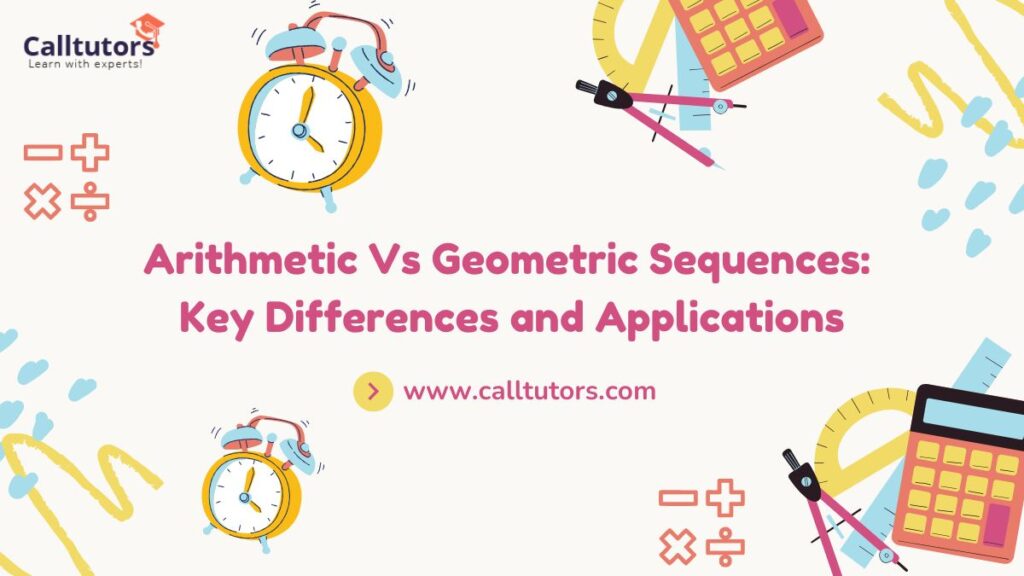When exploring the world of mathematics, two fundamental concepts stand out: arithmetic and geometric sequences. Understanding the differences between Arithmetic Vs Geometric Sequences is crucial for students and professionals alike, as these sequences form the basis for various mathematical applications.
An arithmetic sequence involves a consistent difference between consecutive terms, while a geometric sequence showcases a constant ratio. This article delves into the key differences between these two types of sequences, highlighting their definitions, formulas, and real-world applications.
By grasping the nuances of Arithmetic Vs Geometric Sequences, one can enhance problem-solving skills and better appreciate the mathematical principles that govern numerical patterns.
Understanding Sequences
Table of Contents
Before delving into the specifics of arithmetic vs geometric sequences, it’s important to define what a sequence is in mathematics. A sequence is a collection of numbers organized in a specific order. Each number in the sequence is referred to as a term. Sequences may be finite or infinite. An infinite sequence continues indefinitely, whereas a finite sequence has a set number of terms.
In mathematics, sequences are often used to model real-world phenomena, such as growth patterns, financial calculations, and statistical data. The study of sequences helps mathematicians and scientists analyze trends and make predictions based on observed data. Arithmetic and geometric sequences are the most commonly encountered types of sequences.
Defining Arithmetic Sequences
An arithmetic sequence is a set of numbers in which the difference between any two successive terms is constant. This constant difference is referred to as the common difference and is represented by the letter d. The general form of an arithmetic sequence is expressed as:

For example, consider the arithmetic sequence 3, 6, 9, 12, 15. In this case, the common difference d is 3, as each term increases by 3. The nth term of this sequence can be calculated by substituting the values into the formula.
Also Read:- Arithmetic vs Mathematics
Defining Geometric Sequences
In contrast, a geometric sequence is a sequence where each term after the first is found by multiplying the previous term by a fixed, non-zero number called the common ratio, denoted by rrr. The general form of a geometric sequence can be expressed as:

For example, consider the geometric sequence 2, 4, 8, 16, 32. Here, the common ratio r is 2, as each term is multiplied by 2 to get the next term. The nth term can be calculated using the formula provided.
Key Differences Between Arithmetic and Geometric Sequences
The primary difference between arithmetic vs geometric sequences lies in how the terms are generated.
- Nature of Growth
- In an arithmetic sequence, the terms grow linearly because each term is derived by adding a fixed constant. The growth is uniform, which means the sequence will create a straight line when plotted on a graph.
- In a geometric sequence, the terms grow exponentially as each term is obtained by multiplying the previous term by a constant. This leads to a curved graph, reflecting the rapid increase as the terms progress.
- Common Difference vs Common Ratio
- An arithmetic sequence uses a common difference (d), indicating how much to add to each term to obtain the next term.
- A geometric sequence relies on a common ratio(r), indicating how much to multiply each term to obtain the subsequent term.
- Formulas

- 4. Sum of Terms

Arithmetic Vs Geometric Sequences: Applications
Applications of Arithmetic Sequences
Arithmetic sequences find extensive applications across various fields, including finance, computer science, and everyday life. Here are some key areas where arithmetic sequences are utilized:
Finance
In finance, the concept of an arithmetic sequence is applied in calculating simple interest. For instance, if you invest a certain amount of money and earn a fixed interest rate, the total interest accrued over time can be represented by an arithmetic sequence. Additionally, budgeting often involves arithmetic sequences when determining expenses over several months.
Computer Science
Algorithms in computer science often utilize arithmetic sequences to manage iterations efficiently. For example, loops that increment by a fixed amount each iteration can be analyzed and optimized using arithmetic sequences. Understanding the time complexity of algorithms often involves recognizing the arithmetic patterns they create.
Scheduling
Arithmetic sequences can help you schedule events by determining time intervals. If you have a weekly meeting or a daily class, the start times make up an arithmetic sequence. Knowing the differences allows for more efficient scheduling and planning.
Sports and Games
Many sports rely on arithmetic sequences for scoring and player statistics. For instance, a basketball player who scores a consistent number of points each game creates an arithmetic sequence of scores. Analyzing these sequences can help coaches evaluate performance and make strategic decisions.
Applications of Geometric Sequences
Geometric sequences have unique applications, particularly in fields such as biology, physics, and finance. Here are some areas where geometric sequences are employed:
Compound Interest
One prominent application of geometric sequences is in finance, where they are used to calculate compound interest. When money is invested, it grows exponentially over time based on the principle of geometric growth. The total amount accrued can be modeled using a geometric sequence, allowing investors to predict future earnings.
Population Growth
In biology, population growth models often use geometric sequences to predict how populations will expand under ideal conditions. If a population grows at a constant percentage rate, the number of individuals can be modeled as a geometric sequence, providing valuable insights for ecologists and conservationists.
Physics
In physics, the concept of geometric sequences can be applied in various contexts, such as understanding radioactive decay or calculating distances in a geometric progression. For example, the distance traveled by an object in free fall can be modeled as a geometric sequence due to the constant acceleration of gravity.
Computer Graphics
Geometric sequences are used in computer graphics to render images and animations. Techniques such as fractals and exponential scaling often involve geometric sequences to create visually appealing designs. Understanding these sequences allows designers to create more realistic and dynamic graphics.
Graphical Representation
Understanding how to graph both arithmetic and geometric sequences can provide deeper insights into their behavior.
Graphing Arithmetic Sequences
When plotted on a graph, the terms of an arithmetic sequence create a straight line. This linear relationship highlights the constant addition of the common difference. For example, if you plot the arithmetic sequence 2, 5, 8, 11, you will observe a straight line with a slope equal to the common difference.
Graphing Geometric Sequences
Conversely, when graphing geometric sequences, the terms create a curve. This exponential growth reflects the multiplication of each term by the common ratio. For instance, plotting the geometric sequence 1, 2, 4, 8 will reveal a curve that steepens as the terms progress, indicating rapid growth.
Also Read:- Math Project Ideas
Real-World Examples
To further illustrate the practical applications of arithmetic vs geometric sequences, consider the following examples:
Arithmetic Sequence Example
Imagine a scenario where a teacher decides to award students extra credit for each assignment turned in on time. If the first assignment earns 5 extra points, the second earns 10 points, the third earns 15 points, and so on, the sequence of extra points forms an arithmetic sequence: 5, 10, 15, 20. The common difference is 5, reflecting the consistent increase in points awarded.
Geometric Sequence Example
Consider a bank that offers a savings account with a 5% annual interest rate compounded yearly. If you deposit $1,000 in the account, the balance at the end of each year forms a geometric sequence: Year 1: $1,000, Year 2: $1,050, Year 3: $1,102.50, and so forth. The common ratio is 1.05, representing the 5% growth each year.
Conclusion
In conclusion, the distinctions between Arithmetic Vs Geometric Sequences are fundamental to understanding mathematical principles and their applications. By recognizing the unique characteristics of each sequence, individuals can apply these concepts in various fields, from finance and science to everyday life.
Whether calculating interest, predicting population growth, or analyzing trends, mastering arithmetic and geometric sequences enhances problem-solving skills and promotes a deeper appreciation for the beauty of mathematics. As we continue to encounter numerical patterns in our daily lives, the knowledge of these sequences becomes an invaluable tool for both personal and professional growth.
FAQs
What are some real-world applications of arithmetic sequences?
Arithmetic sequences are commonly used in finance to calculate simple interest, in scheduling to determine time intervals, and in algorithms within computer science to manage iterations efficiently. They are also applicable in sports to analyze player statistics.
How are geometric sequences used in finance?
In finance, geometric sequences are particularly important for calculating compound interest. When an investment grows at a fixed percentage rate, the total amount can be represented as a geometric sequence, allowing for predictions of future earnings based on initial investment and interest rate.



